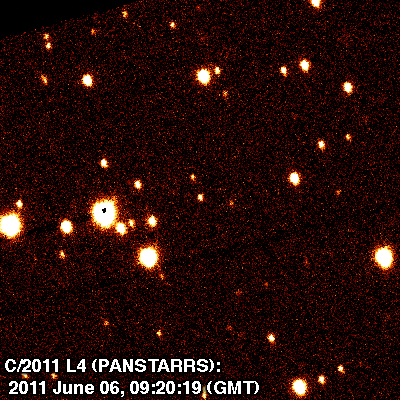New comet and early black holes discovered
July 26th, 2011 | by Malamalama Staff | Published in Research News
University of Hawaiʻi at Mānoa astronomers have discovered a new comet and early evidence of black holes.

Tell-tale movement of Comet PANSTARRS
The comet was found by the Pan-STARRS 1 telescope on Haleakalā and confirmed by UH Mānoa Astronomer Richard Wainscoat and graduate student Marco Micheli using the Canada-France-Hawaiʻi telescope on Mauna Kea.
Based on preliminary orbit projections, it should be visible to the naked eye in early 2013. It is expected to appear brightest in February or March, when it comes within about 30 million miles of the sun, about the same distance as Mercury. The comet will pose no danger to Earth.
Dubbed C/2011 L4 (PANSTARRS), the comet offers a rare opportunity to look at pristine material left over from the early formation of the solar system. It probably originated in the Oort cloud of comet-like objects located in the distant outer solar system; a nudge from the gravity of a distant passing star may have sent it on its long journey toward our sun.
Comets are usually named after their discoverers, but C/2011 L4 bears the name of the telescope in honor of the large team of observers, computer scientists and astronomers involved in the multi-institution initiative to scan the sky nightly for potentially hazardous asteroids. It was first identified by automated software developed by a UH Institute for Astronomy team to analyze the 3-gigabyte images produced by Pan-STARRS’s 1.4-billion-pixel camera.
Read the news release on the discovery or a Mālamalama article about the Pan-STARRS telescope and asteroid-hunting mission.

Composite image combining the deepest X-ray, optical and infrared views of the sky; courtesy of NASA
Meanwhile, the first direct evidence that black holes existed when the universe was less than a tenth of its present age has been reported by UH Mānoa Astronomer Ezequiel Treister and colleagues. Black holes are objects whose gravity is so strong that not even light escapes.
The scientists examined X-ray images—the most sensitive ever taken—from NASA’s orbiting Chandra X-ray Observatory. Analyzing data from the observations, the scientists found a central black hole voraciously consuming gas and stars in 30—100 percent of the 200 distant galaxies they observed.
“Until now, we had no idea what the black holes in these early galaxies were doing, or if they even existed,” Treister says.
A population of very young black holes in the early universe had been predicted, but not previously observed. Detailed calculations show that the total amount of black hole growth observed is about a hundred times higher than recent estimates, the team reports in the June 16, 2011, issue of Nature. They expect the baby black holes will grow into the giants seen today, nearly 13 billion years later.
Read the abstract in Nature or view the animated sequence of images below, which begins with a large optical image of the southern sky, zooms into the 4-million-second exposure of the Chandra Deep Field South and is then overlaid with an optical and infrared image from the Hubble Space Telescope.
Tags: astronomy, Institute for Astronomy, July11 issue, Pan-STARRS, UH Manoa
